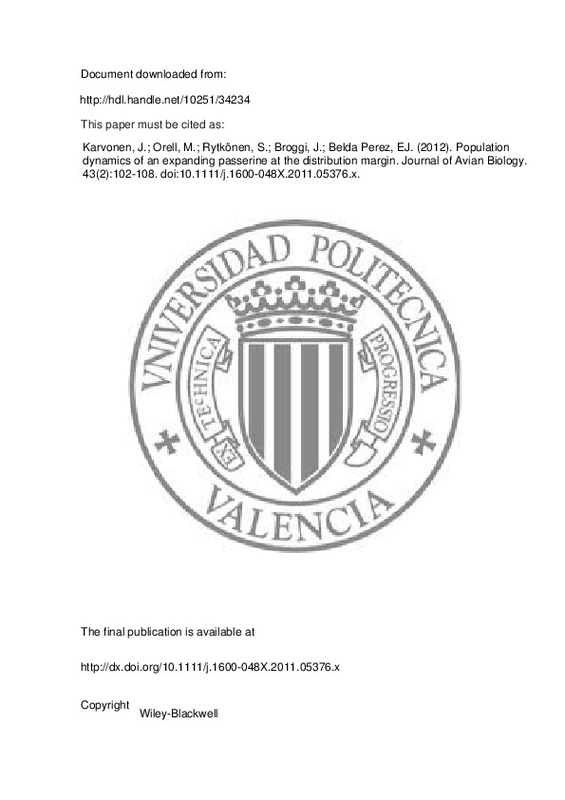Bauchau, V., & Van Noordwijk, A. J. (1995). Comparison of survival estimates obtained from three different methods of recapture in the same population of the great tit. Journal of Applied Statistics, 22(5-6), 1031-1038. doi:10.1080/02664769524775
Broggi, J., Hohtola, E., Orell, M., & Nilsson, J.-Å. (2005). LOCAL ADAPTATION TO WINTER CONDITIONS IN A PASSERINE SPREADING NORTH: A COMMON-GARDEN APPROACH. Evolution, 59(7), 1600-1603. doi:10.1111/j.0014-3820.2005.tb01810.x
Clobert, J., Perrins, C. M., McCleery, R. H., & Gosler, A. G. (1988). Survival Rate in the Great Tit Parus major in Relation to Sex, Age, and Immigration Status. The Journal of Animal Ecology, 57(1), 287. doi:10.2307/4779
[+]
Bauchau, V., & Van Noordwijk, A. J. (1995). Comparison of survival estimates obtained from three different methods of recapture in the same population of the great tit. Journal of Applied Statistics, 22(5-6), 1031-1038. doi:10.1080/02664769524775
Broggi, J., Hohtola, E., Orell, M., & Nilsson, J.-Å. (2005). LOCAL ADAPTATION TO WINTER CONDITIONS IN A PASSERINE SPREADING NORTH: A COMMON-GARDEN APPROACH. Evolution, 59(7), 1600-1603. doi:10.1111/j.0014-3820.2005.tb01810.x
Clobert, J., Perrins, C. M., McCleery, R. H., & Gosler, A. G. (1988). Survival Rate in the Great Tit Parus major in Relation to Sex, Age, and Immigration Status. The Journal of Animal Ecology, 57(1), 287. doi:10.2307/4779
Dhondt, A. A., Adriaensen, F., Matthysen, E., & Kempenaers, B. (1990). Nonadaptive clutch sizes in tits. Nature, 348(6303), 723-725. doi:10.1038/348723a0
Dingemanse, N. J., Both, C., van Noordwijk, A. J., Rutten, A. L., & Drent, P. J. (2003). Natal dispersal and personalities in great tits (
Parus major
). Proceedings of the Royal Society of London. Series B: Biological Sciences, 270(1516), 741-747. doi:10.1098/rspb.2002.2300
Doncaster, C. P., Clobert, J., Doligez, B., Gustafsson, L., & Danchin, E. (1997). Balanced Dispersal Between Spatially Varying Local Populations: An Alternative To The Source‐Sink Model. The American Naturalist, 150(4), 425-445. doi:10.1086/286074
Gould, W. R., & Nichols, J. D. (1998). ESTIMATION OF TEMPORAL VARIABILITY OF SURVIVAL IN ANIMAL POPULATIONS. Ecology, 79(7), 2531-2538. doi:10.1890/0012-9658(1998)079[2531:eotvos]2.0.co;2
GREENWOOD, P. J., HARVEY, P. H., & PERRINS, C. M. (1978). Inbreeding and dispersal in the great tit. Nature, 271(5640), 52-54. doi:10.1038/271052a0
Greño, J. L., Belda, E. J., & Barba, E. (2008). Influence of temperatures during the nestling period on post-fledging survival of great tit Parus major in a Mediterranean habitat. Journal of Avian Biology, 39(1), 41-49. doi:10.1111/j.0908-8857.2008.04120.x
HORAK, P., & LEBRETON, J.-D. (2008). Survival of adult Great Tits Parus major in relation to sex and habitat; a comparison of urban and rural populations. Ibis, 140(2), 205-209. doi:10.1111/j.1474-919x.1998.tb04380.x
Kawecki, T. J. (2008). Adaptation to Marginal Habitats. Annual Review of Ecology, Evolution, and Systematics, 39(1), 321-342. doi:10.1146/annurev.ecolsys.38.091206.095622
Kokko, H. (2006). From Individual Dispersal to Species Ranges: Perspectives for a Changing World. Science, 313(5788), 789-791. doi:10.1126/science.1128566
KVIST, L., ARBABI, T., PÄCKERT, M., ORELL, M., & MARTENS, J. (2007). Population differentiation in the marginal populations of the great tit (Paridae: Parus major). Biological Journal of the Linnean Society, 90(2), 201-210. doi:10.1111/j.1095-8312.2007.00726.x
Lampila, S., Orell, M., Belda, E., & Koivula, K. (2006). Importance of adult survival, local recruitment and immigration in a declining boreal forest passerine, the willow tit Parus montanus. Oecologia, 148(3), 405-413. doi:10.1007/s00442-006-0386-3
Lebreton, J.-D., Burnham, K. P., Clobert, J., & Anderson, D. R. (1992). Modeling Survival and Testing Biological Hypotheses Using Marked Animals: A Unified Approach with Case Studies. Ecological Monographs, 62(1), 67-118. doi:10.2307/2937171
Lenormand, T. (2002). Gene flow and the limits to natural selection. Trends in Ecology & Evolution, 17(4), 183-189. doi:10.1016/s0169-5347(02)02497-7
Matthysen, E., Adriaensen, F., & Dhondt, A. A. (2001). Local recruitment of great and blue tits (Parus major, P. caeruleus) in relation to study plot size and degree of isolation. Ecography, 24(1), 33-42. doi:10.1034/j.1600-0587.2001.240105.x
ORELL, M. (2008). Population fluctuations and survival of Great Tits Par us major dependent on food supplied by man in winter. Ibis, 131(1), 112-127. doi:10.1111/j.1474-919x.1989.tb02750.x
ORELL, M., LAHTI, K., & MATERO, J. (2008). High survival rate and site fidelity in the Siberian Tit Parus cinctus, a focal species of the taiga. Ibis, 141(3), 460-468. doi:10.1111/j.1474-919x.1999.tb04415.x
Payevsky, V. A. (2006). Mortality rate and population density regulation in the great tit, Parus major L.: A review. Russian Journal of Ecology, 37(3), 180-187. doi:10.1134/s1067413606030064
Postma, E., & van Noordwijk, A. J. (2005). Gene flow maintains a large genetic difference in clutch size at a small spatial scale. Nature, 433(7021), 65-68. doi:10.1038/nature03083
Pradel, R. (1996). Utilization of Capture-Mark-Recapture for the Study of Recruitment and Population Growth Rate. Biometrics, 52(2), 703. doi:10.2307/2532908
Pulliam, H. R. (1988). Sources, Sinks, and Population Regulation. The American Naturalist, 132(5), 652-661. doi:10.1086/284880
Rytkonen, S., & Orell, M. (2001). Great tits, Parus major, lay too many eggs: experimental evidence in mid-boreal habitats. Oikos, 93(3), 439-450. doi:10.1034/j.1600-0706.2001.930309.x
Rytkonen, S., & Krams, I. (2003). Does foraging behaviour explain the poor breeding success of great tits Parus major in northern Europe? Journal of Avian Biology, 34(3), 288-297. doi:10.1034/j.1600-048x.2003.03041.x
Sasvari, L., & Orell, M. (1992). Breeding Success in a North and a Central European Population of the Great Tit Parus major. Ornis Scandinavica, 23(1), 96. doi:10.2307/3676432
Tinbergen, J. M. (2004). Strong evidence for selection for larger brood size in a great tit population. Behavioral Ecology, 15(4), 525-533. doi:10.1093/beheco/arh045
Väisänen R. A. Lammi E. Koskimies P 1998 Muuttuva pesimälinnusto Otava, Keuruu
Verhulst, S., Perrins, C. M., & Riddington, R. (1997). NATAL DISPERSAL OF GREAT TITS IN A PATCHY ENVIRONMENT. Ecology, 78(3), 864-872. doi:10.1890/0012-9658(1997)078[0864:ndogti]2.0.co;2
Visser, M. E., & Verboven, N. (1999). Long-Term Fitness Effects of Fledging Date in Great Tits. Oikos, 85(3), 445. doi:10.2307/3546694
White, G. C., & Burnham, K. P. (1999). Program MARK: survival estimation from populations of marked animals. Bird Study, 46(sup1), S120-S139. doi:10.1080/00063659909477239
[-]







![[Cerrado]](/themes/UPV/images/candado.png)


